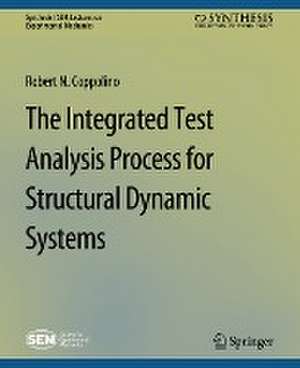The Integrated Test Analysis Process for Structural Dynamic Systems: Synthesis / SEM Lectures on Experimental Mechanics
Autor Robert N. Coppolinoen Limba Engleză Paperback – 15 noi 2019
Preț: 349.25 lei
Nou
Puncte Express: 524
Preț estimativ în valută:
66.85€ • 72.64$ • 56.19£
66.85€ • 72.64$ • 56.19£
Carte tipărită la comandă
Livrare economică 17-23 aprilie
Preluare comenzi: 021 569.72.76
Specificații
ISBN-13: 9783031797286
ISBN-10: 3031797280
Pagini: 148
Ilustrații: XV, 148 p.
Dimensiuni: 191 x 235 mm
Editura: Springer International Publishing
Colecția Springer
Seria Synthesis / SEM Lectures on Experimental Mechanics
Locul publicării:Cham, Switzerland
ISBN-10: 3031797280
Pagini: 148
Ilustrații: XV, 148 p.
Dimensiuni: 191 x 235 mm
Editura: Springer International Publishing
Colecția Springer
Seria Synthesis / SEM Lectures on Experimental Mechanics
Locul publicării:Cham, Switzerland
Cuprins
Preface.- Overview of the Integrated Test Analysis Process (ITAP).- Definition of Test Article Finite Element Models.- Systematic Modal Test Planning.- Measured Data Analysis.- Experimental Modal Analysis.- Systematic Test Analysis Correlation.- Reconciliation of Finite Element Models and Modal Test Data.- Author's Biography.
Notă biografică
Robert N. Coppolino received his formal education in New York City having graduated from Stuyvesant High School and earned a B.S. Aerospace Engineering, and an M.S. and Ph.D. in Applied Mechanics at the Polytechnic Institute of Brooklyn. As a structural dynamics engineer at Grumman Aerospace Corporation (1967-1975), he supported the Lunar Module, Skylab, and Space Shuttle programs, and contributed to development of techniques for launch vehicle pogo (instability) suppression and propellant tank hydroelastic modeling and test-analysis correlation. From 1975-1983, Dr. Coppolino was at The Aerospace Corporation, ultimately holding the post of manager of the Engineering Dynamics Section. While at Aerospace, he supported NASA's Space Shuttle Pogo Integration Panel, developed the Simultaneous Frequency Domain (SFD) method for experimental modal analysis, and defined innovative residual vector techniques that were successfully employed in Space Shuttle nonlinear payload interface flight loadspredictions and detection of structural damage on offshore jacket platforms. From 1983-1987, he served as manager of the Advanced Methods and Development branch at the MacNeal-Schwendler Corporation (MSC). During his stay at MSC he led a consortium composed of MSC, the J. S. Bendat Company, and Synergistic Technology Incorporated, which developed technologies that were ultimately called the Integrated Test Analysis Process (ITAP). From 1987 to the present, Dr. Coppolino has held various senior posts at Measurement Analysis Corporation, currently serving as Chief Technology Officer for Torrance Operations. During this period he collaborated closely with the late Julius S. Bendat on development of nonlinear spectral techniques for identification of nonlinear systems. In addition, Dr. Coppolino continued development of ITAP components including efficient procedures for modal test-analysis reconciliation. The full suite of ITAP capabilities experienced its first end-to-end, "prime-time" applicationon the International Space Station P5 Short Spacer modal test, conducted at NASA/MSFC in 2001. In 2016, Dr. Coppolino was invited to join the NASA Engineering Safety Center, Loads and Dynamics Technical Discipline Team (LDTDT) as an industry member. Since that time, he has provided independent review of NASA's SLS and Orion programs, and as part of this work developed procedures aimed at dealing with the "many modes" problem. A highlight of these activities is development of SFD-2018, which appears to provide the impetus for a Roadmap for a Highly Improved Modal Test Process. Robert Coppolino is married to Catherine (Stafford) Coppolino, a person of outstanding courage and love for others. Together they have five children, Michael, Melisssa, Kenneth, Peter, and James, who have blessed them with seven wonderful grandchildren, Hannah, Hailey, Jakob, Robert, Ryder, Drew, and Tyler.




